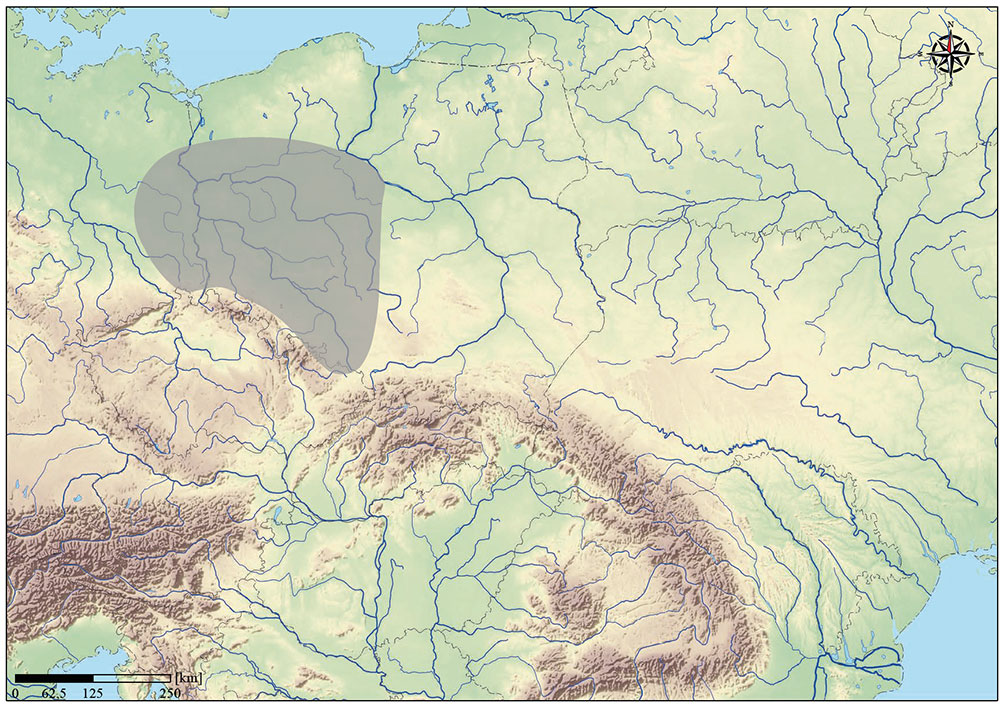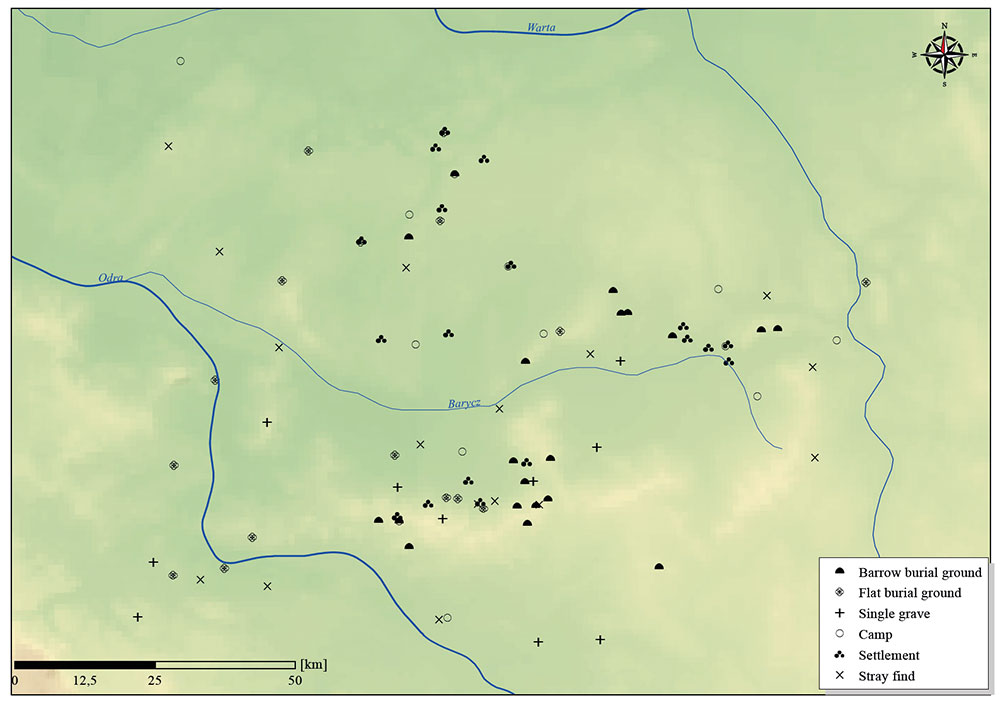Interesting chapter The birth of a new world. Barrows, warriors, and metallurgists, by Przemyslaw Makarowicz. In: Urbańczyk P. (Ed.) THE PAST SOCIETIES. Polish lands from the first evidence of human presence to the Early Middle Ages, Warszawa 2017, vol. 3, U. Bugaj (Ed.) (2000 – 500 BC), Warszawa, pp. 127-186.
Some interesting excerpts from the introduction (emphasis mine):
In the 17th century BC the northern reaches of the Únětice culture oecumene experienced a structural crisis and a settlement hiatus; no such interruption in development occurred in the southern or western regions, or further west in the circle of the Blechkreiskulturen (Innerhofer 2000; Müller 2012, 257f.). In light of the most recent research, the decline of Únětice structures in the north was associated with a growing social and ecological crisis that resulted e.g., in the well-documented regression in the development of the fortified settlement in Bruszczewo in Greater Poland/Wielkopolska, which occurred ca. 1650/1600 BC (Kneisel 2012; Kneisel 2013, 101f.; Müller 2012). The settlement structure in that region only stabilized after several decades, with the emergence of Tumulus culture (Schurbein 2009; Cwaliński 2012, 16). In some parts of Central Europe (e.g., Bohemia, Bavaria, Hesse, Thuringia) a relatively gradual and smooth transition in the form of bronze items and pottery was observed between the periods of BA2 and BB1, diagnostic for the Early and Middle Bronze Age respectively (Rittershofer 1984; Innerhofer 2000). The term ‘pre-Tumulus’ horizon (BA3) was introduced to denote the stage that followed the disappearance of Early Bronze Age cultural structures and preceded the formation of Tumulus culture at the foothills of the Alps (Innerhofer 2000, 241f.)
The processes behind the development of this new cultural phenomenon may become clearer if one considers the origins of the new ideology of warriorhood apparent in the most progressive formations of the late stages of the early Bronze Age in the Carpathian Basin (Vandkilde 2007, 129; 2014; the beginnings of the Middle Bronze Age in Hungarian chronology; Hänsel 1968; Bóna 1992; Harding 2000, Fig. 1.3).This factor is particularly relevant in the case of the centralized communities of the Otomani-Füzesabony culture. Its members built impressive fortified settlements, knew advanced methods of bronze casting, and maintained a vast network of contacts that connected the north of Europe with the eastern reaches of the Mediterranean world (e.g., Bouzek 1985; Furmánek, Veliačik, Vladár 1991; Kristiansen, Larrson 2005; David 2007)
(…)
The composition of some spectacular hoards and the presence of military items in some of the graves associated with such communities may suggest that a new type of individualized elite (military aristocracy) emerged in this very culture (Kristiansen 1998, 376f.; 1999; Kristiansen, Larrson 2005). The attractive ideology would then have spread to the west and north-west and be adapted by the ‘post-Early-Bronze’, de-centralized and mobile communities (most likely based on kinship) of animal farmers inhabiting the upper Danube basin and the upper Rhine basin, as well as by the peoples of the Nordic regions (Vandkilde 2014, Fig. 5). This process went hand in hand with the dissemination of the custom of tumulus-building and the associated religious concepts, funerary practices, and territorial behaviour. The mechanism behind the adoption of this custom remains unknown. It may have been the result of imitating the barrows of Corded Ware culture, already present in the landscape of Central Europe – a similar process took place in the communities of the Trzciniec circle (Makarowicz 2009; 2010; 2011). It is also possible that the tumuli were based on the few existing Únětice barrows, though in this case the similarities are more apparent in the stone elements beneath the barrows’ mound. In both cases there was no direct contact between the earlier cultural formation and the emerging group.

The new lifestyle became a pan-European phenomenon, but involved a considerable degree of regional diversity that stemmed primarily from contact with local tradition (Bóna 1975; Gedl 1989; Jockenhövel, Kubach [eds.] 1994; David 2002; Jockenhövel 2013). But how did this model spread? It appears that analogies for this development may be found in the social processes and interactions that took place at the beginning of the 3rd millennium BC and led to the emergence of the Bell Beaker phenomenon (Burgess 1986; Nicolis 2001 [ed.]; Czebreszuk 2001; 2004 [ed.]; Heyd 2013; Van der Linden 2013, further literature therein). The most important elements of the ‘Tumulus set of cultural patterns’ included: warriorhood (conveyed through the presence of individual weaponry as grave goods), characteristic types of territorial behaviour (methods of familiarizing space that largely relied on constructing tumuli – monumental graves with a unique external form and internal architecture that was singular, spectacular, and immensely symbolic), and a specific array of valuables made of bronze or, less frequently, of amber or glass (such items indicated the status, gender, and sometimes also the social role of the deceased with whom they were buried). Local cultural milieux transmitted and adapted a set of ideological, social, and political principles that gave the emerging formation coherence and a new ‘quality’. The symbolism of the stone barrow construction (rings, kerbs, cores, rays, etc.), the high value of bronze and amber, and the emergence of the custom of cremation suggests that ‘Tumulus’ communities had a large part to play in the dissemination of the solar cult during the Middle Bronze Age (cf. Kristiansen, Larsson 2005; Czebreszuk 2011, 164-171).
The decline of the Central European early Bronze Age civilization and the birth of a new, pan-European formation was a complex process that lasted at least several decades. It may be surmised that the downfall of Únětice structures and the Otomani-Füzesabony-Gyulavarsánd complex in the Carpathian Basin was brought about primarily by internal structural crises, yet the reasons for the emergence of Tumulus culture lay in the attractive, almost ‘Dionysian’ ideology of warriorhood. Its solidification coincided with the decline of the ‘old’ Early Bronze Age elites that ruled over centralized structures that were territorial in character (fortified settlements with proto-urban characteristics) and were buried in magnificent, richly furnished graves covered with mounds (Fürstengräber). It was also concurrent with the emergence of active kinship-based and de-centralized groups led by the ‘new’ elite class of warriors (the beginnings of military aristocracy?). The significance of such groups continued to grow during the pivotal period – and the decline of the Únětice world and the final turbulent phase of the development of centres in the Carpathian Basin may well be thus described. The process was facilitated by the escalation of military conflicts that occurred in the Bronze Age (Harding 1999; 2007; Kristiansen 1999; Osgood, Monks, with Thoms 2000; Kristiansen, Larsson 2005; Hårde 2006; Vandkilde 2011; 2014). War became an inherent part of social life, as indicated by the increasing presence of weaponry in male graves, rock carvings and steles depicting warriors and their equipment, as well as arrowheads and spearheads embedded in the bones (soft tissues) of the deceased, and plentiful evidence of injuries caused by melee weapons (e.g., Osgood 2006). New types of weaponry (swords, spears) started to be used in the first half of the 2nd millennium BC, leading to more efficient methods of combat (e.g., Harding 2006; Thrane 2006). This must have resulted in the emergence of new types of units, combat styles, and military strategies. It may also be surmised that ‘Tumulus’ communities adopted a hitherto unknown, institutionalized model of warriorhood based on groups of men who dealt with warfare professionally (cf. Sarauw 2007, 66).
The origin of the Tumulus culture meant therefore a pan-European ideological socio-political and ideological change, that may be associated with the last true North-West Indo-European dialect continuum in Europe, as evidenced in Archaeology by long-distance cultural contacts, in Linguistics potentially by late layers of shared vocabulary, and in Ancient Genomics by the different origins of combatants studied from the the Tollense valley.

The origins of Tumulus culture in what is now Polish territory most likely resulted from a combination of different factors. In the hitherto prevailing narrative its arrival in the Odra-middle Vistula interfluve was associated with an invasion (aggressive migration) of the Tumulus peoples from enclaves in the middle Danube basin, the destruction of Únětice centres and the Nowa Cerekwia Group, and the subsequent conquest of the western territories inhabited by members of the Trzciniec culture (Gedl 1975, 81; 1989; 1992; Gediga 1978). There is, however, much evidence to suggest that the provenance of this cultural group is more complex.
Recent archaeological research and environmental analyses indicate that the decline of the Únětice culture in the northern reaches of its scope (e.g., the economic and settlement crisis of the Kościan agglomeration with its centre in Bruszczewo and the princely barrow graves in Łęki Małe) was mainly the result of excessive human activity and overly intense exploitation of natural resources (Kneisel 2012; 2013; Müller 2012). Palynological data from the period of1700-1500 BC collected in this part of the North European Plain indicates a decline of human activity. It coincides with the devolution of settlement centres (hamlets and necropolises) dated to the end of the Early Bronze Age and the beginning of the Middle Bronze Age (depopulation?). The decline of Early Bronze Age settlements occurred between 1700 and 1600 BC, whereas the beginning of the Silesian-Greater Polish Tumulus culture may be dated to 1600-1500 BC. A renewed increase in human activity, indicated e.g., by the ‘opening’ of the landscape, did not occur until ca. 1500-1400 BC, in the classic period of the development of ‘Tumulus’ cultural structures (Kneisel 2012, 221).
The whole paper is interesting from the point of view of the potential formation of a Proto-Balto-Slavic community in the Proto-Lusatian or Silesian-Greater Polish Tumulus culture, before its expansion to the east.
After O&M 2018, the only plausible alternative to this model of Balto-Slavic homeland is that Proto-Lusatian represents a Temematic community instead, and an Indo-Slavonic community formed in East Yamna, whereby Balto-Slavic would have possibly expanded with Srubna, and only much later over Temematic territory, absorbing its language as a North-West Indo-European substratum.
See also:
- The significance of the Tollense Valley in Bronze Age North-East Germany
- The Tollense Valley battlefield: the North European ‘Trojan war’ that hints to western Balto-Slavic origins
- Germanic tribes during the Barbarian migrations show mainly R1b, also I lineages
- mtDNA suggest original East Germanic population linked to Jutland Iron Age and Bell Beaker
- Admixture of Srubna and Huns in Hungarian conquerors
- The concept of “Outlier” in Human Ancestry (III): Late Neolithic samples from the Baltic region and origins of the Corded Ware culture
- Genetic prehistory of the Baltic Sea region and Y-DNA: Corded Ware and R1a-Z645, Bronze Age and N1c
- Bell Beaker/early Late Neolithic (NOT Corded Ware/Battle Axe) identified as forming the Pre-Germanic community in Scandinavia
- Heyd, Mallory, and Prescott were right about Bell Beakers